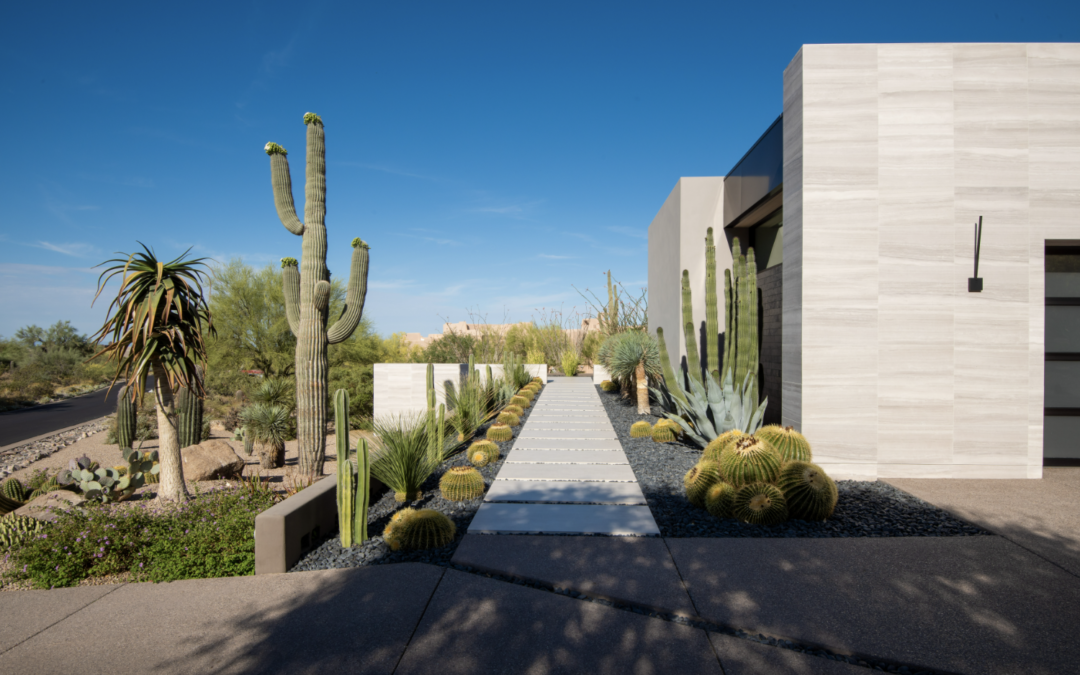What is Xeriscaping?
Xeriscaping is a landscaping approach that focuses on designing gardens and landscapes that require minimal water usage. The word “xeriscape” comes from the Greek word “xeros,” meaning dry. This form of landscaping is very popular in the Sonoran Desert for obvious reasons.
The Seven Principles of Xeriscaping
Now that you’re familiar with xeriscaping let’s explore the seven principles of xeriscaping to give you a better understanding of what it entails:
#1 Planning & Designing
First, assess your current landscape and develop a ‘foundational plan.’ This diagram, drawn to scale, should showcase the major elements of your landscape, including the house, driveway, sidewalk, deck or patio, and existing trees and other features.
If you’re undertaking the project without the help of a landscaping company, you’ll need to measure the property lines to your house and record the dimensions of all exterior walls, as well as solid surfaces like sidewalks, decks, and driveways. Then, transfer your measurements to graph paper. Most designers prefer to work with plans drawn to a 1:10 or 1:8 scale.
We suggest collaborating with a professional landscaping company, as this is a tedious task prone to errors. Without expertise, there’s a risk of creating a poorly designed landscape plan.
#2 Soil Improvements
Front-range soils fall into two categories: sandy and clay. Clay soil is dense and retains water for a long time. While sandy soil doesn’t hold much water, and plants can dry out unless frequently irrigated. Non-native plants might require soil amendments, but native plants typically don’t. Adding 1 to 2 inches of organic material 6 inches deep can improve most soils’ water retention.
#3 Efficient Irrigation
Irrigation for a xeriscape can be done manually or through an automatic sprinkler system. If you opt for the sprinkler system, it’s important to incorporate its presence into your landscape design. It’s essential to separate turf areas from other plants and choose irrigation methods that best suit each area. Low-pressure, low-angle sprinklers work well for grass, while drip, spray, or bubbler emitters are great for watering trees, shrubs, flowers, and groundcovers.
If you prefer hand watering, opt for sprinklers that release drops close to the ground, avoiding those that throw water high in the air or create a fine mist. To minimize water loss through evaporation, avoid watering between the hours of 10 a.m. and 6 p.m.
#4 Plant Zones
Different parts of your yard receive different light, wind, and moisture levels. To conserve water effectively, cluster plants with similar light and water needs and position them in areas that meet these requirements. High-water plants should be placed in spots with ample drainage, near downspouts, or shaded by other plants.
Opt for low-water plants suited to our climate for dry, sunny locations or areas distant from a water source. Introducing a mix of plants with different heights, colors, and textures adds visual interest and enhances the landscape appeal.
#5 Mulches
Mulch serves several purposes: it keeps plants cool, prevents soil from forming crust, reduces evaporation, and minimizes weed growth.
Organix mulches like bark chips, pole peelings, or wood grindings should be applied at a minimum depth of 4 inches. These mulches – which decompose gradually- are ideal for new beds. As plants mature and expand, they will naturally cover the mulch areas.
Inorganic mulches, such as rocks and gravel, should spread at least 2 inches deep. They rarely require replacement and are suitable for windy locations. However, it’s advisable not to place them alongside the house on the sunny south or west sides, as they tend to retain and radiate heat.
#6 Turf Alternatives
Classic Kentucky bluegrass is lush and hardy. However, it requires a significant water supply. To conserve water, consider decreasing the bluegrass turf in your landscape.
Embrace native or low-water use plants, constructing patios and decks, or applying mulch can enhance your landscape’s aesthetics while reducing water consumption. Additionally, consider planting alternative turfs like buffalo grass, blue grama grass, turf-type tall fescue, and fine fescues to minimize water usage in your landscape.
#7 Maintenance
Caring for a new xeriscape garden initially resembles traditional landscaping but reduces over time. The early maintenance stages may include watering, weeding, annual pruning of perennials and native grasses, and necessary shrub and tree pruning.
Now that you know all about xeriscaping, you’re ready to transform your yard into a minimal-water landscape. Xeriscaping can be a big job. It’s advisable to seek professional help. Feel free to reach out to us at (480) 488-0128 or, fill out a contact form here.









